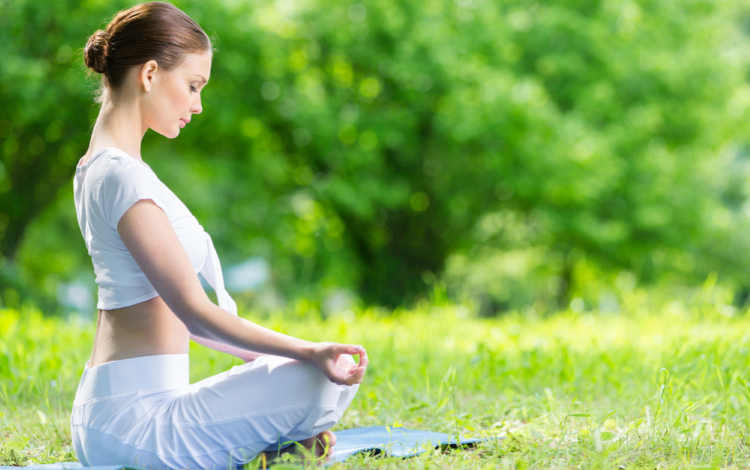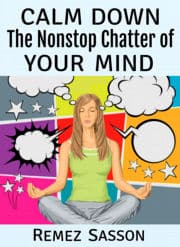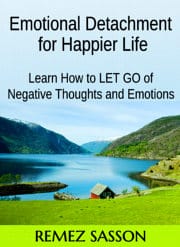
Are you looking for simple but effective meditation techniques? I have written several articles about meditation techniques suitable for beginners and more experienced people. You can find them here, on this website.
People who know little about meditation consider it a meaningless practice unsuitable for modern life. Others think it is a form of religious or prayer practice.
This assumption is entirely wrong due to a lack of enough information.
Browse our online courses on meditation, positive thinking, overcoming procrastination, confidence, and freedom from distractions.
Table of Contents:
Meditation Cultivates Self-Awareness, Tranquility, and Equanimity
Meditation is one of the best ways to improve the quality of life and enjoy inner peace and happiness. It has been practiced worldwide for thousands of years in various forms in the East and the West.
Meditation cultivates self-awareness, tranquility, and equanimity. It leads to self-reflection and introspection and fosters heightened self-awareness that allows one to see life from a broader perspective.
Meditation also enables one to make conscious choices and respond calmly rather than react impulsively to people and situations.
I don’t mean to convince you to meditate if you have never done so. However, there is a large body of evidence supporting its usefulness and benefits.
Many scientific experiments have been done about it, and millions of people have practiced it and have gotten positive results in the past and the present.
I, too, have had positive experiences through many years of practice, and that’s why I am writing about meditation.
Before talking about meditation techniques, I want to mention the benefits of meditation.
What Are the Benefits of Meditation?
Meditation has always been a method for reaching and realizing the Inner Self, the Spirit, and one’s essence and arriving at higher levels of consciousness.
In the West, especially in the last decades, people discovered that it reduces stress, calms the mind and emotions, and contributes to better physical, emotional, and mental well-being.
This is most important, and in our high-stress society, it is most welcome.
However, let us remember its other benefits, both mental and spiritual, as taught in Buddhism, Zen, Advaita Vedanta, and other Eastern Traditions.
Here is a list of some of the benefits of meditation you can gain regardless of which meditation method you follow.
- It calms the body, emotions, and mind.
- It releases stress and anxiety.
- Meditation fosters a state of inner peace, free from worries and fears.
- Better focus and control of the mind and thoughts.
- Clarity of thinking.
- You learn to live in the present moment.
- Raising above limited thinking and mental programming and gaining a free mind.
- Self-realization – Realizing your true Self and knowing who you really are.
- Spiritual awakening.
- Meditation paves the way to rising above the ego and awakening to a greater Self.
Meditation Requires Regular Practice
If you want results, you need to practice daily meditation. Of course, skipping a session occasionally is okay if you are too busy or tired.
You need to train yourself every day. It is like bodybuilding. If you exercise your body only once in a while, you might get some results, but real results require constant training. The same is valid for meditation.
Various Meditation Methods
There are various types of meditation, all of which involve focusing your attention on something. As your attention wanders away, you bring it back to the meditation.
There are many meditation techniques, such as mantra, candle, breathing, guided meditation, mindfulness, and transcendental meditation.
Here, we will focus on seven meditation techniques. I devoted a special post to each meditation with guidance and instructions. You will find a short description and a link to the post teaching each meditation technique.
Related: What is meditation
7 Meditation Techniques
Some might find certain techniques more difficult, while others may find them easier to practice. This depends on various factors such as your strength of focus, earnestness, motivation, experience, etc.
Try each form of meditation for a few days to find the one you are most comfortable with, then stick with it.
After some time, if you feel that you have made progress with your current technique, you may try a different one.
All the meditations presented here will strengthen your focus and concentration and bring you calmness and inner peace.
“I Am Meditation” and “Self-Inquiry Meditation” aim to raise awareness above the ego and realize one’s real essence. I recommend gaining experience with the others before practicing them.
Remember, practicing every day is essential, preferably at more or less the same hour.
Reading provides the information and understanding of what you need to do, but the practice takes you to your goal and ensures success.
1. Mantra Meditation
The mantra meditation technique is an effective method of meditation to still the mind and gain control over the thinking process.
A mantra is a word, sound, or short phrase repeated repeatedly to focus the mind and calm its restlessness.
A mantra can be the sound “OM”, a short inspiring sentence, or a positive and relaxing word, such “peace”, “happiness” or “serenity”.
From experience, I know it is a potent meditation that helps silence the mind and awaken inner peace.
Learn about Mantra Meditation.
2. Candle Meditation
Candle meditation is a simple meditation technique in which you focus your sight and attention on the flame of a candle for a certain length of time.
The flame of a candle has some mystery in it. It flickers and changes shape. It produces a halo and displays several colors. All this fascinates the mind and puts it in a relaxed mood.
In this situation, it is easier to focus the mind and the attention, disregard the chatter of the mind, and experience inner peace.
Learn how to practice candle meditation.
3. Water Meditation
Find a quiet place on the shore of a lake, sea, or river bank. You can sit on a bench, if there is one, on a rock or the floor.
Watch the water, waves, or ripples for a few minutes. You do not need to do anything else. Enjoy the quietness while watching the water calmly.
In this meditation, the water and the calm environment will bring calmness and peace to your mind.
Learn how to practice water meditation.
4. Walking Meditation
Walking meditation is a good alternative if you are busy and cannot find the time or a quiet place to meditate.
This practice is a valuable and effective way to release stress and free the mind from useless thinking. It can also improve one’s control of the mind and thinking process.
You can practice this meditation while walking in the park, on the street, on your way to and from work, or anywhere else.
Learn about walking meditation.
5. Watching Thoughts Meditation
Watching your thoughts dispassionately and without getting involved with them will calm your mind, strengthen your concentration, and reduce the number of thoughts passing through your mind.
Of course, to get results, you will need to practice daily for at least ten minutes each time.
You need to watch your thoughts with detachment and lack of interest. This is not easy for a beginner, but with patience and persistence, you will make progress.
Learn about watching thoughts meditation.
6. “Who Am I” Meditation
The Real “I” is like a bright bulb of light hidden from sight by many covers. We must strip away the covers, which are our thoughts, feelings, beliefs, and habits. By stripping them away, we uncover the internal bright light of our true being.
How do we strip these covers? We do so by calming the nonstop chatter of the mind and asking ourselves who we are in some specific way.
This meditation will help you become aware of your real essence, delve within yourself, and discover the “I”, the consciousness beyond the mind.
7. Self-Inquiry Meditation
This meditation is the same as the “Who am I” meditation mentioned above.
There is a deeper consciousness inside everyone, hidden beneath layers of thoughts, feelings, and desires.
You can peel away obstacles that hide your inner consciousness through simple steps. This process is simple and uncomplicated, but its rewards are great.
This method was taught by the great spiritual teacher Sri Ramana Maharshi.
While practicing it, you keep asking yourself, “Who am I?” When thoughts arise in your mind, ask yourself to whom this thought belongs.
While practicing this meditation method, do not analyze each thought, worry, or fear that pops into your mind. Don’t get involved with them; just look at them with a lack of interest.
You will learn to detach yourself from your thoughts and worries and not allow them to occupy your awareness.
Final Words
All these techniques provide relaxation and stress relief by letting you quiet your mind and enter a state of deep relaxation. This helps to reduce anxiety, promote mental clarity, and restore inner peace.
On a higher level, they can lead to spiritual awakening.
Remember, sticking with one good meditation technique is enough. Going impatiently from one meditation practice to another without persistence is not a good choice.
Our online meditation course explores these methods in detail, and provides guidance and advice for practicing them.
Learn About Our Online Meditation Course
Various meditation techniques for finding inner peace, expanding consciousness, and awakening.
Additional Information and Resources
You might also like reading:
Top Meditation Guidance and Useful Tips for Everyone
Why Meditate? Reasons and Advice
Meditation for Beginners: A Comprehensive Guide
Image source – DepositPhotos
Browse our online courses on meditation, positive thinking, overcoming procrastination, motivation, confidence, and freedom from distractions.



